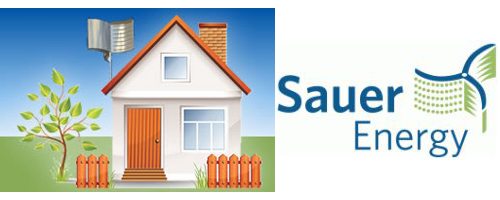
This is a Sponsored post written by me on behalf of Sauer Energy for SocialSpark. All opinions are 100% mine.
The cost of all forms of energy we use daily is going up. The continually rising price of gasoline seems to be driving up the cost of everything we use. The energy we need to heat, cool, and power our homes is no exception to rising prices, and we all are feeling the pinch. We can buy hybrid cars to help with our gasoline bills, but there have been few options for controlling the cost of energy for our homes – and our precious gadgets! – and those options tend to be limited to expensive solar panels or building specially designed buildings from the ground up. Other than the sun, there is one energy source that’s free, safe, and often plentiful – the wind. Let’s see how Sauer Energy can help us safely harness the wind.
Gone are the days of the picturesque windmills turning lazily in the open fields. Today’s wind turbines are usually giant propellers on 300-ft tall structures, spinning at high speeds. They take up a lot of space and they are noisy. They are very dangerous – have you ever seen a video of one of those things ripping itself apart? – and are often devastating to bird populations. The cost of these structures means you couldn’t afford one for your home, even if the dangers weren’t a consideration. Enter Sauer Energy’s Vertical-Axis Wind Turbine (VAWT).
Sauer’s wind turbine is relatively small. It’s about six feet in diameter and about 3 feet tall. It can be installed on existing structures, and it requires only 2 feet of clearance above the roof. You can have them painted with company logos or even landscape or sky “camouflage” patterns. Their small size means they can be turned with only a 5mph wind, so they will be effective in many geographic areas. They are also quiet, and their vertical orientation makes them much safer for bird populations.
Sauer Energy estimates that a typical installation will cost between $6000 and $15,000, depending on the configuration and output. In windier areas, they predict that a VAWT will provide 25-50% of the electricity for a typical home and will pay for itself in about 24 months.
Check out these videos of a VAWT assembly and of wind-tunnel testing.
Meet Joe… from Dieter Sauer on Vimeo.
You can also learn more about the company’s plan for making these wind turbines available to help you control your energy costs safely. Remember, the energy you save helps protect the earth, and the money you save can be used to feed your gadget habit!




Gadgeteer Comment Policy - Please read before commenting
Wow – you’re brave!! I’ll make a start.
If $15k pays for itself in 24 months at 25% then then some of you are paying $2500 a month for leccy! Personal aluminium smelter perhaps?
In the UK my electricity bill is $27 a month (and I’m about $150 in credit) – so my payback time at the bottom end of the installation cost estimate and top end of the efficiency would be about twenty years.
Am I missing something? Maybe you can sell surplus back to the grid at very high prices and you’ve not mentioned this.
?
H_G: Your calculations are right on. The numbers just don’t add up to make personal wind turbines very economical. There’s a definite economy of scale here: large turbines can generate electricity at about the same price as fossil fuels, but personal ones just don’t do it. There are much better ways to spend your ‘green’ dollars (e.g., insulation). Not as glamorous, but it makes a much bigger difference to the earth, and to your savings.
Thank you for this – Stock is @ .51cents
Sounds like a good plan
Look at the data they provide (http://sauerenergy.com/index.php?option=com_content&view=article&id=162) and you quickly see the problem. Unless you have some fairly steady wind at 20+ mph the output is very low and at 20mph would handle my AC (in the Texas Heat) but nothing else.
Wind power is a near useless form of green energy for nearly all homes.
The problem is that the wind near a urban home, even a suburban home, is very, very low. Like 5 miles an hour on average.
That’s mainly due to two reasons: (1) wind travels very slowly near the surface of the earth due to ground turbulence, and (2) urban/suburban centers generate heat, which pushes the cooler winds higher up.
The only people who benefit from wind power are rural homes that happen to be located in flat, wide open, windy regions. And those people would use a large windmill (with 20+ ft blades), rather than the tiny windmills picture here.
I’ve been researching green energy options for my home, and the conclusion I’ve reached is that solar plus conservation techniques are the only viable options for urban or suburban home owners.
It depends on where you live if wind power is right for you. I live in the desert and use solar panels to provide electric power for all my needs. At night I run off of batteries that have been charged during the day. I keep adding panels as I go along- right now I got about 1KW of panels. I had a Southwest Air wind generator about 10 years ago. It was nothing but a pain in the butt: wouldn’t start charging until wind reached 11MPH or so, it sounded like a jet taking off in high winds, and it shook to where I had to climb high up to tighten the bolts that worked loose. The one wind turbine presented here by Janet wouldn’t have most of those problems.
I’m happy with my solar panels but was wondering what the unit price on one of these Sauer wind turbines is?
To those of you speaking of the costs and money returns, keep in mind that with government Renewable Energy kickbacks the actual system cost to the homeowner is much smaller. Also, from the research I have been doing I understand that the addition of Renewable Energy Facilities to a home adds equity to your home.
The claims made for this turbine don’t add up. Their website is very unclear about what the swept area is but if we take the dimensions in the above article and call it 1.8m x 0.9m and apply the formula for calculating the power in the wind then the total available power in the wind at 5m/sec ( a good average wind speed) is 124 watts. If we assume that it is 30% efficient then it would extract about 37 watts at that speed.
The average US household uses around 12,000Kw-hrs/yr so even at 25% it would need to generate 3000 KW’s in a year. No way!
Also to pay for itself in 2 years – you have a projected cost of $7,000 plus installation, say $10,000 – a total of $17,000 & let’s say you get a tax rebate of 30% and your electricity costs 15cents per KW-hr – you would then need to generate 90,000 KW-hrs per year – an obvious impossibility I know these are rough figures but I reckon the payback period would not be in your lifetime or that of your children.
The makers of turbines such as these continue to do a disservice to the wind industry with their ridiculous claims.